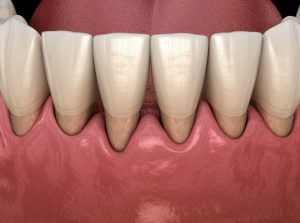 Did you know cavities aren’t the only threat to your oral health? Gum (periodontal) disease is also a leading cause of tooth loss. Although it’s preventable, the Centers for Disease Control and Prevention reports that 50% of adults have it. Not only can it wreak havoc on your smile, but research has found an increased risk of developing several serious health issues, like cardiovascular disease and Alzheimer’s disease. Each stage of the infection requires different treatments. Here’s what you need to know about gingivitis and periodontitis.
Did you know cavities aren’t the only threat to your oral health? Gum (periodontal) disease is also a leading cause of tooth loss. Although it’s preventable, the Centers for Disease Control and Prevention reports that 50% of adults have it. Not only can it wreak havoc on your smile, but research has found an increased risk of developing several serious health issues, like cardiovascular disease and Alzheimer’s disease. Each stage of the infection requires different treatments. Here’s what you need to know about gingivitis and periodontitis.
What Causes Gum Disease?
Gum disease is caused by bacteria found in tartar from poor oral hygiene habits. The infection can progress painlessly, and the initial signs of it can be overlooked. Unfortunately, bleeding, swollen, and inflamed gums can eventually lead to tooth loss. Your dentist can detect the infection early at routine cleanings and checkups. Besides cleaning your teeth, they also check the depths of the periodontal pockets. If the infection is present, they’ll use the information to determine the stage of gum disease for the appropriate treatment, which includes:
Gingivitis
Gingivitis is the first stage of gum disease, which is easy to treat and won’t cause any long-term damage to your smile. Your gums can become inflamed and irritated. It’s not unusual for them to bleed when brushing or flossing your teeth. You may also notice bad breath or a foul taste in your mouth. Often, a deep cleaning and changes to your home oral hygiene habits are all that’s needed to treat the infection. However, if gingivitis is ignored, gum disease can progress to periodontitis.
Periodontitis
Periodontitis occurs when gum disease reaches advanced stages, which will cause the inner layer of the gum and bone to pull away from your teeth. The periodontal pockets will become larger and trap more bacteria. Plaque will spread below the gum line, destroying the tooth and jawbone.
Periodontitis can cause your teeth to shift, gum recession, visible pus pockets, sensitivity, and even tooth loss. The infection may also enter your bloodstream, leading to various health concerns. Advanced gum disease requires more complex treatment and restorative procedures may be required to repair any damage.
Protect Your Smile from Gum Disease
You can safeguard your smile from gum disease with a great home oral hygiene routine. Besides brushing your teeth in the morning and at night, don’t forget to floss. Brushing leaves 40% of your teeth’s surfaces uncleaned. Flossing is the only way to remove the buildup left behind by your toothbrush. Use an antimicrobial mouthwash to kill any bacteria lingering in your mouth. Don’t forget to schedule a cleaning and checkup every 6 months. A clean smile will keep your mouth and body healthy.
About Dr. Avi Shainhouse
Dr. Shainhouse is a board-certified periodontist. After earning his dental degree at the University of Western Ontario, he continued his education for 3 years to become a periodontist. He specializes in periodontics and dental implants. If you have signs of gum disease, don’t wait. Contact our office today to request an appointment.
